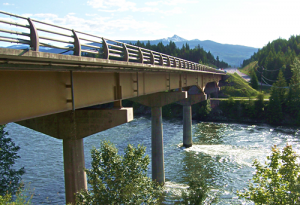Run silent, run deep isn’t a phrase you’ll hear too often when we talk about highways, but we actually do spend a fair bit of time underwater. The reason isn’t too surprising, given that we live on the coast and have so many lakes, rivers and streams. We need lots of bridges and docks to get around, and their supports are often submerged. Keeping those supports standing strong is vital, so underwater inspections are an important part of our regular maintenance routine.
These inspections generally begin with a hydrographic survey, where we use boats and sonar to map and study the bottom of waterways. What we’re looking for is something called scour. That’s when water pushes riverbed soils and gravel away from a structure’s supports. This is an ongoing challenge, because when we put something in the water, like a support for a bridge, the current tends to flow around it faster (as you can see in the image above). The faster water can increase erosion, so ironically the very thing supporting the bridge is what can make it weaker. In fact, scour is one of the leading causes of bridge failure.
If we do find scour, we can use riprap to make sure things stay stable. Riprap is basically just a lot of large rocks, and we commonly use it to control erosion and increase stability (If you’re curious, you can see a picture of riprap along a riverbank on our Flickr site).
In addition to the hydrographic survey, we hire specially trained divers to do visual inspections. They’re looking for things like rotting wood, metal corrosion, cracking concrete or anything else that might indicate a structure needs attention. Some need this more than others, so we’ve got a tailored schedule for everything we look after that’s underwater. It could be once every five years or even once every 15, it all depends on how the structure was built, what it was made from and the surrounding water conditions.
It’s not so much The Hunt for Red October as it is the hunt for scour holes and rot, but it’s still a watery tale to whet your interest.

Join the discussion